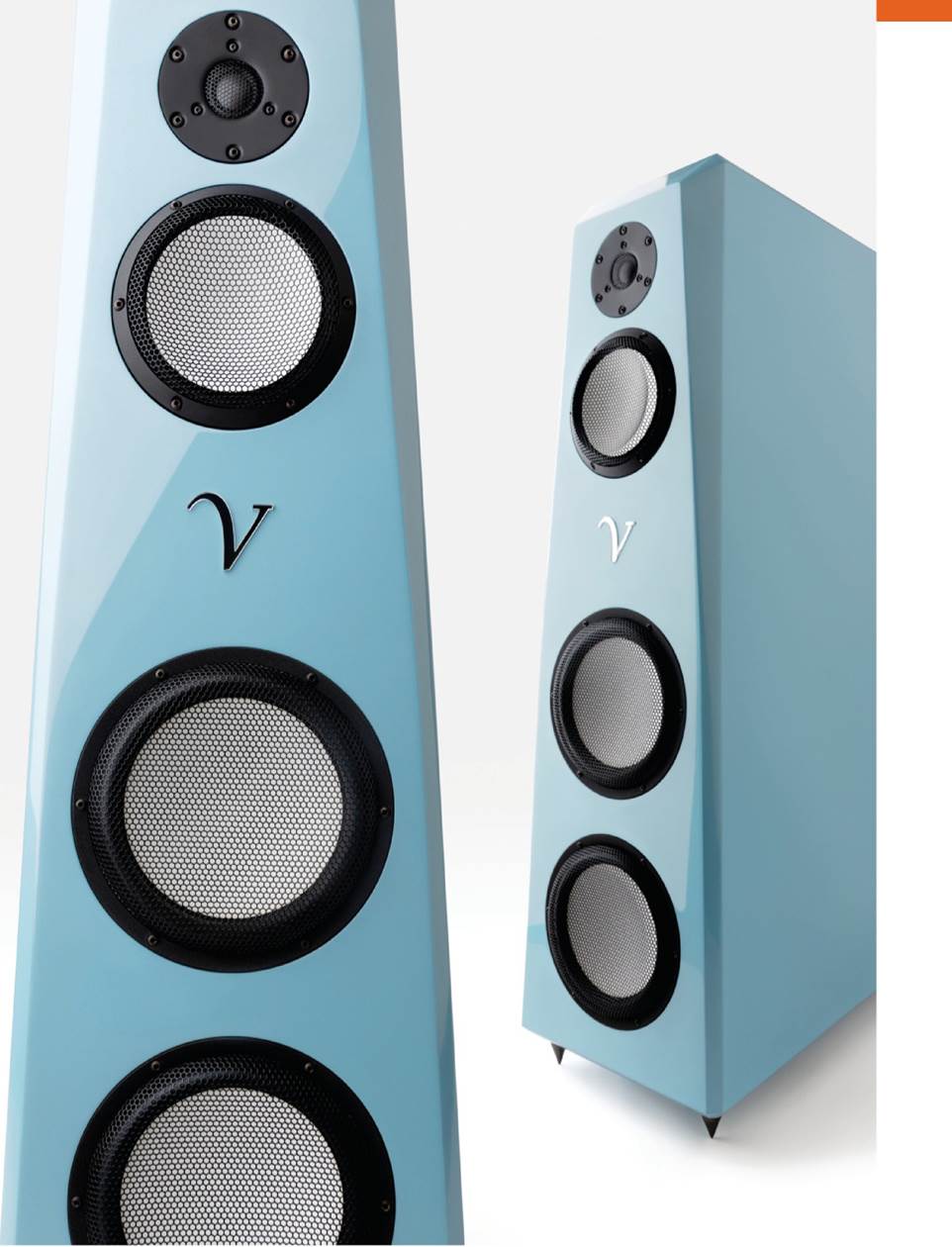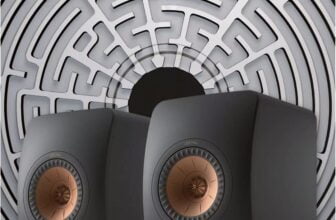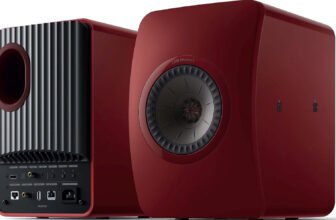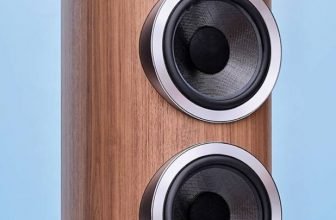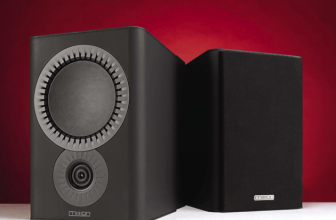Von Schweikert Ultra 55 Review
Achieving room-filling, high-quality sound in a hotel room is difficult enough. Getting it in a cavernous ballroom is even more problematic. Yet, over the past few years at AXPONA, RMAF, and most recently at the February 2020 FLAX (Florida Audio Expo), Von Schweikert Audio, in association with The Audio Company of Marietta, Georgia, has managed that—and, other than the approximately 100 bodies occupying every seat in the house, they’ve done it without any room treatment, or without any that I could see.
At various shows, the company delivered equally impressive sonic goods with either the monolith-like $325,000/ pair Ultra 11 or with the far smaller Ultra 55 reviewed here. The Ultra 9, priced between the two, fills out the Ultra line. While big rooms usually have “hot spots” of good sound and “dead spots” of poor sound, the Von Schweikerts seemed to shower everyone with good sound, wherever they sat or stood.
At one show, I played Side 2 of Abbey Road (PCS 7088) digitized at 24/96 from an original UK pressing; the crowd sat transfixed through a whole side of a very familiar record. People got up teary-eyed or even weeping outright. A few said they’d “never heard it like that.” That was in part due to my analog front end’s decoding of an original UK pressing, but it was also because the system in the big room delivered the kind of well-balanced sonic presentation you don’t often hear in hotel rooms, big or small. It surprised me.
Familiar elements on that record, and on others I spun on vinyl there, usually get ruined or disappear entirely in hotel rooms: the bottom end goes soggy or bloated; transients lose their grip or are too sharp. But in that room near the Tampa airport, they sounded ideal, or at least recognizably similar to how they sound at home under much better conditions.
I’ve never heard my reference Wilson Audio Specialties Alexx speakers perform as well at shows as they do at home, and occasionally they’ve sounded downright awful, so hearing these Von Schweikerts sound so right at shows had me wondering how they might sound at home. When a pair of the relatively compact Ultra 55s was offered for review, of course I said “yes.”
The Ultra 55s in Bleu Celeste
Albert Von Schweikert founded his namesake company in 1996 after having worked for years for other speaker manufacturers. His impressive bio is worth reading.
Albert stepped aside in 2015, turning the business over to his son Damon and appointing Leif Swanson chief designer; Swanson had spent a decade working with Albert. The current line was developed under Swanson’s guidance, but it’s based on Albert’s concepts, particularly regarding crossover design. The Ultra 55s use drivers developed by Von Schweikert (the company) in collaboration with Ac- cuton and Scan-Speak. Swanson, who is also the company’s vice president of sales and marketing, says the Ultra 55s are voiced to sound identical to the larger Ultra 9 and Ultra 11, although, in a relatively compact (42″ H x 13″ W x 24″ d) package, they offer a bit less of everything. The Ultra 55 weighs 190lb—hefty, but far less than the Ultra 9’s 500lb.
The Ultra 55 is not a square box. The flawlessly finished cabinet—a complex, triple-wall, constrained-layer-damped, bonded laminate of 1″ MDF, 1″ HDF, and a 3/4” proprietary artificial stone—is narrow at the tweeter-top and widens down to the woofer-bottom. Von Schweikert calls the multilaminate cabinet construction “Version 2.0 Active Cabinet Vibration Control.” The composite design is said to be as much about vibration cancelling as it is about damping.
The rear and front panels slope gently, with the front panel chamfered at the top to minimize diffraction. That sloping front aligns the front-firing drivers’ acoustic centers, ensuring, Von Schweikert says, that the wavefronts from the front-firing drivers are mechanically time-aligned without any crossover tweaks.
The cabinet’s superb fit’n’finish and flaw-free polyester
specifications
Description Three-way, reflex-loaded, floorstanding loudspeaker with 525W powered-woofer option. Drive-units: 1″ (25mm) beryllium-dome tweeter, 6″ (168mm) ceramic-dome midrange, two 8” (220mm) ceramic/honeycomb sandwich woofers. Crossover frequencies: 200Hz, 2kHz. Frequency range: 20Hz- 40kHz. Nominal impedance: 4 ohms. Minimum impedance: Not specified. Sensitivity: 88dB/W/m. Dimensions 42″ (1066mm) H x 13″ (330mm) W x 24″ (609mm) D. Weight: 190lb (86kg) each. Finish: “any automotive polyester color.” Serial number of units reviewed 004. Made in USA.
Approximate number of dealers: 11. Warranty: 5 years.
Manufacturer
Von Schweikert Audio, 1040-A Northgate St., Riverside, CA 92507.
Tel: (951) 682-0706. Web: vonschweikert.com.
paint job (here in Bleu Celeste but available in “nearly endless colors,” according to Mr. Swanson) helped produce an attractive, graceful-looking package.
You can order the Ultra 55 with or without a 525W class-D woofer amp. The review sample came with. It drives the two rear-ported, reflex-loaded 8″ (220mm), custom- designed, Accuton-built ceramic/ honeycomb-sandwich woofers featuring “overhung” motors, 38mm vented voice-coils, and soft-rubber surrounds.
Above the woofers is a recently developed 6″ (168mm) Accu- ton “4D” (“Direct Dome Driver Design”) ceramic-dome midrange driver; 4D means the spider isn’t connected to the former; instead, the former connects to the rubber surround, which allows the former to be shorter. This design minimizes interactions with the dome and moves the driver’s acoustical center farther forward.
The tweeter is an in-house-modified version of ScanSpeak’s Illuminator 99% beryllium-dome tweeter, which is claimed to produce flat response to beyond 40kHz, outstanding off-axis dispersion, high resolution, and “silky-
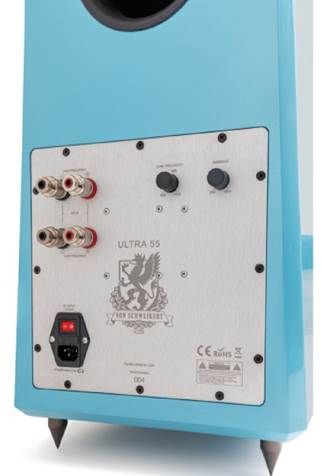
smooth” sound; it features a large roll surround and an unusual magnet configuration: a circular array of six neodymium “slugs” in place of the usual single magnet. This open-magnet structure is said to eliminate reflections and resonances and produce “far lower distortion than any other tweeter design.”
A custom, Von Schweikert-de- veloped, 3″ Fountek aluminum- ribbon supertweeter on the back panel fires frequencies above about 10kHz at the front wall and completes the driver complement.
For the fourth-order, point-to- point, hand-wired, 200Hz and 2kHz crossover networks, Von Schweikert uses copper-foil inductors, which the company considers the least colored, lowest-distortion inductors available, and Mundorf capacitors, chosen from two recently developed lines that Von Schweikert says are the most accurate. Internal wiring is from MasterBuilt—a brand designed and constructed by “leaders in the Aerospace industry.” (Von Schweikert is MasterBuilt’s global distributor.)
Von Schweikert crossovers employ two technologies— Acoustic Inverse Replication (A.I.R.) and Global Axis Inte-
Measurements
Because of the Von Schweikert Ultra 55’s bulk and weight, I drove my measurement gear to Michael Fremer’s place in deepest, darkest New Jersey to perform the measurements. I chose a day that was forecast to be sunny with minimal wind, because I was going to measure the speaker in his driveway, so that the only source of reflections would be the ground. (Even so, the proximity of the ground necessarily led to aggressive windowing of the time-domain data, which reduced the measurements’ midrange resolution.) I first measured the speaker’s spatially averaged response in Mikey’s listening room, then we maneuvered one of the speakers onto a small dolly—easier to write than do, given the Ultra 55’s 190lb weight and its spikes—and wheeled it outside. To avoid heating up the drive-units, I positioned the speaker with its back to the sun, facing the garage where I had set up my gear. I used DRA Labs’ MLSSA system and a calibrated DPA 4006 microphone to measure the Von Schweikert Ultra 55’s farfield behavior and an Earthworks QTC-40 microphone for the nearfield and in-room measurements.
As always, I used my Krell KSA- 50 amplifier for the quasi-anechoic measurements with MLSSA; for the in-room behavior the speakers were driven by the Valve Amplification Company Statement 452 IQ monoblocks that were reviewed in the May issue and that Mikey had been using for most of his auditioning.
Von Schweikert specifies the Ultra 55’s sensitivity as a moderately high 89dB/W/m, which was confirmed by my estimate. The Ultra 55’s nominal impedance is specified as 4 ohms. The solid trace in fig.1 reveals that, while the impedance does average 4 ohms in the treble, it is higher than that in the midrange. The minimum magnitude is 3.6 ohms at 2.3kHz. However, there is a combination of 4 ohms magnitude and a phase angle (dashed trace) of -50° at 2kHz. As music can have high energy in this region, the amplifier used with the Von Schweikert speaker must be comfortable driving 2 ohms. Although the electrical phase angle becomes extreme at low frequencies, the magnitude is extremely high in this region, mitigating any drive difficulty. This behavior is due to the use of a high-pass filter in the feed to the midrange unit and tweeter, because of the Ultra 55 using an internal amplifier to drive the woofers.
The impedance traces are free from the small discontinuities that would imply the presence of cabinet resonances. When I examined the vibrational behavior of the Ultra 55’s enclosure with a plastic-tape accelerometer, the only resonant mode I found was on the sidewall level with the midrange unit (fig.2). This mode is high in both frequency and Q (Quality Factor) and is very low in level. It is safe to say that
Stereophile Von Schweikert Ultra 55 Impedance (ohms) & Phase (deg) vs Frequency (Hz)
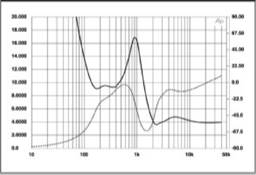
Fig.1 Von Schweikert Ultra 55, electrical impedance (solid) and phase (dashed) (2 ohms/vertical div.).
it will have no effect on sound quality. The Von Schweikert’s enclosure is effectively inert.
The two powered woofers behave identically. The blue trace in fig.3 shows the sum of their nearfield outputs, with their passband output normalized to that of the midrange unit. (There is a level control for the woofers.) The notch at 27Hz indicates that this is the tuning frequency of the 4″-diameter port on the rear panel. The port’s output (red trace), plotted in the ratio of the square roots of its and the woofers’ radiating areas, peaks broadly between 15Hz and 55Hz, suggesting that the Ultra 55 is a true full-range loudspeaker. The port’s upper-frequency rollout is free from any resonant peaks.
The woofers roll off rapidly above 200Hz, with the midrange unit (fig.3, black trace) rolling in above that frequency. Other than a slight excess of energy in the presence region, the Von Schweikert’s output in the midrange and low- and mid-treble, averaged across a 30° horizontal window centered on the tweeter axis, is commendably flat. There is a gentle rolloff in the top audio octave, reaching -6dB at 20kHz. When I substituted the Earthworks microphone for the DPA, the response still gently sloped down above 11kHz.
The plot of the Ultra 55’s horizontal dispersion, referenced to the response on the tweeter axis (fig.4), reveals that this apparent rolloff is due in part to the fact that the output of the tweeter drops off relatively quickly to the sides above 10kHz. Averaging the output over the 30° horizontal window centered on the tweeter axis downplays the flatter on-axis response
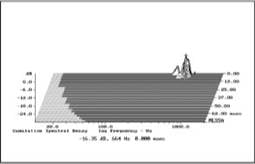
Fig.2 Von Schweikert Ultra 55, cumulative spectral- decay plot calculated from output of accelerometer fastened to sidewall level with midrange unit (MLS driving voltage to speaker, 7.55V; measurement bandwidth, 2kHz).
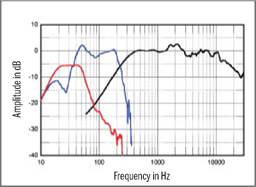
Fig.3 Von Schweikert Ultra 55 anechoic response of tweeter and midrange unit at tweeter height, at 50″, averaged across a 30° horizontal window and corrected for microphone response, with nearfield responses of the woofers (blue) and port (red), respectively plotted below 350Hz and 250Hz.
in this region.1 The apparent peak just below 3.5kHz off-axis in this graph is due to the slight lack of energy in this region in the on-axis response filling in to the speaker’s sides. Other than that and the top-octave rolloff off-axis, the contour lines in this graph are relatively even, which correlates with stable stereo imaging. In the vertical plane (not shown), the Ultra 55’s response doesn’t change over a ±5° window centered on the tweeter axis, which is 38″ from the floor.
The red trace in fig.5 shows the
1 When the response is measured at a single position, some of the fine detail in the treble will be specific to just that one point in space. When I started measuring loudspeakers 30 years ago, I decided to implement some kind of spatial averaging to smooth out any position-dependent wrinkles in the measured response while leaving the significant information intact. Accordingly, my published responses are the average of seven measured responses, taken at 5° intervals across a 30° horizontal window centered on the reference axis.
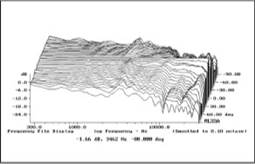
Fig.4 Von Schweikert Ultra 55, lateral response family at 50″, normalized to response on tweeter axis, from back to front: differences in response 90-5° off axis, reference response, differences in response 5-90° off axis.
Von Schweikerts’ spatially averaged response in Michael Fremer’s listening room, driven by the V.A.C. monoblocks, with the woofer and rear-tweeter level controls as set for his auditioning. (This trace is generated by averaging 20 spectra, taken for the left and right speakers individually in a vertical rectangular grid 36″ wide by 18″ high and centered on the positions of his ears.) For reference, the blue trace shows the spatially averaged response of the Wilson Alexx speakers that Mikey reviewed in the May 2017 issue of Stereophile2 and subsequently purchased to use as a long-term reference. (The Wilsons were driven by Michael’s darTZeel NHB-458 monoblocks for this measurement.) The responses are normalized at 1kHz, and the Von Schweikerts can be seen to have a more even in-room response than the Wilsons from 400Hz to 6kHz. The outputs of both pairs of speakers between 80Hz and 400Hz are disturbed by room
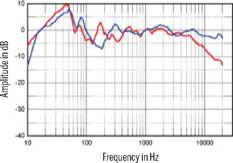
Fig.5 Von Schweikert Ultra 55, spatially averaged, 1/6-octave response in MF’s listening room (red) and of the Wilson Alexx (blue).
acoustics effects that have not been eliminated by the spatial averaging. Below that region, the Ultra 55s excite the lowest-frequency mode in Mikey’s room to a greater extent than the Alexxes, something I could hear when I performed the in-room measurement.
The Von Schweikerts’ in-room output starts to shelve down in the mid-treble to a greater extent than the Wilsons, but then rolls off relatively quickly in the top octave due to the tweeter’s limited top-octave dispersion. By contrast, the Alexxes have a little too much energy in this region. When I listened to some music, as I always do when I visit Michael—his system always sounds superb—the Ultra 55s did sound a touch too sweet.
Turning to the time domain, the step response of the upper-frequency units on the tweeter axis (fig.6) indicates that the tweeter and midrange unit are connected in positive acoustic polarity. The decay of the tweeter’s
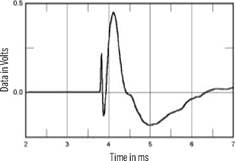
Fig.6 Von Schweikert Ultra 55, step response of upper-frequency drive-units on tweeter axis at 50″ (5ms time window, 30kHz bandwidth).
step blends smoothly with the start of the midrange unit’s woofer’s step, which suggests optimal crossover design. I had the woofers turned off for this measurement to eliminate their reflections from the ground, but a separate measurement indicated that the woofers are also connected in positive acoustic polarity. Finally, the Von Schweikert’s cumulative spectral- decay plot (fig.7) is impressively clean in the treble, though the slight excess of on-axis energy centered on 2kHz is associated with some low-level delayed energy. And as this measurement was taken on the tweeter axis with no spatial averaging, you can see that the gentle top-octave rolloff doesn’t start until 15kHz rather than the 11kHz shown in fig.3.
Overall, the Von Schweikert Ultra 55’s measurements indicate excellent audio engineering.—John Atkinson
2 See stereophile.com/content/wilson-audio- specialties-alexx-loudspeaker.
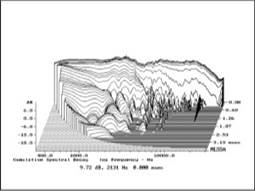
Fig.7 Von Schweikert Ultra 55, cumulative spectral- decay plot on tweeter axis at 50″ (0.15ms risetime).
gration Network (G.A.I.N.)— which work together to befuddle this reviewer.2 These technologies have a secondary goal of making the music sound better.
G.A.I.N. is a crossover topology that “constructs a consistent polar response both in the amplitude and time domains, both horizontally and vertically,” according to a Von Schweikert white paper. “Not only does this radiation pattern enable the listener to perceive well-balanced frequency and harmonic integration from almost anywhere in the listening side of the room; it also enhances sound-stage imaging over a 180-degree axis horizontally
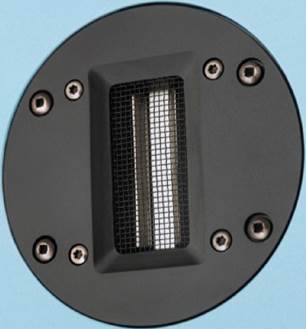
and 70 degrees vertically. This is especially important psychoacous- tically, since the ear/brain hearing mechanism responds favorably to this reconstructed sound wave pattern. Proprietary circuits form steep 24dB acoustic crossover slopes at specially selected frequencies without the penalties of induced ringing and excessive phase delay.”
A.I.R. exploits G.A.I.N. to replicate “the inverse of a recording microphone signal,” in the specific case of a spaced-omni microphone pair, allowing it, in combination with the rear-firing Ambience Retrieval System (A.R.S.), “to recreate the space and depth heard in the concert hall.”
2 See vonschweikert.com/designer-bio-cjbm.
There will be no rear-firing A.R.S. jokes here from me.
I didn’t know about any of this when I heard at those hi-fi shows, from both Von Schweikert Ultra loudspeakers, those unique and enveloping spatial qualities even under challenging acoustical conditions. Sometimes ignorance can be enlightening.
Easy setup
Mr. Swanson flew in for the setup shortly before COV- ID-19 put an end to most air travel and visitation. Thanks in great part to the level-adjustable powered woofers, it didn’t take long to properly locate the speakers, which ended up farther into the room than my reference Wilson Audio Specialties Alexx, somewhat farther from the side walls, and only slightly toed-in. The Ultra 55s were close to where the Vandersteen Model Seven’s—the last pair of powered speakers I reviewed here—sat back in 2010.
Both the powered woofer and ambient channel levels were set by ear via rear-panel-mounted pots; this was quick and easy and I never felt it necessary to change the levels during the review period. I tried three cables, two of which I had on hand—AudioQuest Dragon and TARA Labs Omega Evolution SP—and one provided by Von Schweikert: Mas- terBuilt Ultra biwire cables. The first two cables were auditioned with VSA-supplied jumpers, the latter with jumpers removed. I used the MasterBuilts for most of my auditioning; they fit nicely between the lean, clean Audio-Quests on one side and the supple, somewhat soft TARAs on the other. The cable deniers are wrong, but costs like these—1/3 as much as these rather expensive speakers—give them something to complain about.
My review work commenced with the Ultra 55s driven by the VAC Statement 452 iQ Musicbloc amps, which I reviewed in Stereophites May issue and which have worked so well with the Ultra 55s (and other Von Schweikert speakers) at shows.[3] I later switched to my reference, the darTZeel NHB-468 monoblocks, which I reviewed in the November 2019 issue.
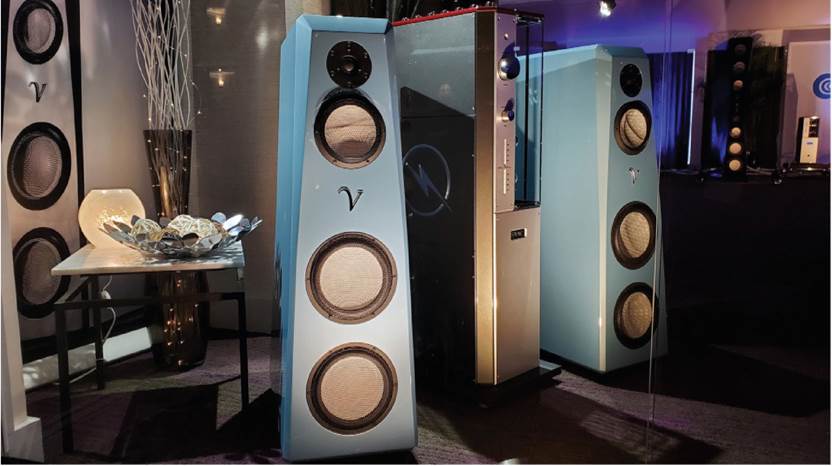
I can’t recall another speaker I’ve reviewed or owned that was so well behaved off-axis.
Agreeable but hardly bland
Big loudspeakers are the hardest things to review. If you’re reviewing a piece of electronics, especially a small piece, you can move back and forth between it and your reference by moving over cables. But with a big loudspeaker, you have to live with them for the whole the review period, since moving them is a two- (sometimes three-) person job.
Usually with new speakers there’s an adjustment period: It takes time to acclimate to the different timbral and spatial perspective. But jumping into the Ultra 55s’ sonics was easy. I immediately liked what they did, especially timbrally, thanks partly to flawless, seamless driver integration: The drivers sang as one, producing an agreeable picture that was rich and supple in the middle, extended, sweet, and airy on top, and assertive and full-bodied on bottom but never obtrusive.
Powered-woofer integration can be problematic. You hear assertive bass, so you turn it down. Then it’s anemic, so you turn it back up. Rinse, repeat.
Here, the blend was seamless with both the tubed VAC and solid-state darTZeel amplifiers. The bass was set “by ear,” to my preference, with Mr. Swanson adjusting as I listened. Only when I went to retrieve the serial number, late in the review period, did I notice it had been set to just about 0dB—very near the middle, in other words.
Pressed to find fault with the spectral balance, I’d say the top end was ever so slightly mellow and the mids a bit forward—either that, or I’m acclimated to more-recessed mids—but when asked to be aggressive on top, it delivered all the edge and sharpness you’d want or expect. On recordings demanding warmth, I got all of it.
The recently released The Girl and the Cat (2 45rpm LPs, Drive on Records 115115 17) is an engaging, deeply heartfelt, beautifully recorded weepfest from Lori Lieberman, accompanied by the Matangi String Quartet. This recording is intimate to the point of “what am I doing eavesdropping on her in her bedroom?” It’s a great record to play for your wife or girlfriend if you want to score points or impress her with your stereo system.
On this record, you don’t want so much as a hint of mood-destroying edge or stridency on Lieberman’s intimate vocals—nor do you want the strings that caress her sorrows to melt into sludge.
The Ultra 55s nailed it: Lieberman’s voice hung in three dimensions between the speakers surrounded by the lush, well-textured, equally 3D strings, combining to produce a close facsimile of the live event, which I experienced in the 599-seat Zan- kel Hall, downstairs from Carnegie Hall.
I went from there to Mobile Fidelity’s superb double-45 reissue of Miles Davis’s “Porgy and Bess” (MFSL 2-485), orchestrated by Gil Evans, an inexplicably bright, bass-shy Frank Laico recording. The Ultra 55s presented an honest rendering of this groundbreaking 1959 album, with clear, clean brass transients with no added etch or glare, so that each brass element was focused and discernible. Gil Evans’s upper-register-heavy arrangement calls for four trumpets, four tubas, four French horns (including Gunther Schuller), woodwinds, and reeds. The Ultra’s top end sorted them all out without added glare, grit, or smearing.
Davis’s horn floated vividly on a 3D center stage, well in front of the drums, immersed in artificial reverb. Those drums—from Philly Joe Jones and (on four tracks) Jimmy Cobb—were reproduced with the kind of transient speed, clarity, delicacy, and precision that would more than satisfy fans of planar or electrostatic speakers. Here you get speed, delicacy, extension, and wide-stage, even coverage—as well as effortless dynamic slam and low-frequency extension— although there’s no LF extension on this Miles record!
You do get the low lows, and all the rest, on a new Beethoven Triple Concerto release with Yo-Yo Ma, Anne- Sophie Mutter, and Daniel Barenboim conducting the West-Eastern Divan Orchestra, which I streamed in MQA on Tidal (vinyl, CD, and Blu-ray are also available from Deutsche Grammophon). It’s a fine live recording that showcases the Ultra 55’s strengths—those I’ve already mentioned such as timbral accuracy and textural delicacy, and others I haven’t mentioned yet, including fine microdynamic expression and an especially graceful attack and decay. The venue isn’t listed, but the space sounds cavernous, imparting a pleasing warmth that occasionally overwhelms, though through the Ultra 55s it doesn’t swallow the three soloists, who appear in clear relief, centered in front of the orchestra on a compact soundstage, appropriate to the somewhat distant perspective.[4] A speaker with excess lower midrange and low end would swallow this recording whole.
Above: Von Schweikert’s Ultra 55 displayed with the VAC Statment 450i iQ integrated amplifier.
Take the aisle seat
When I sat in the off-center seat in my room, the Ultra 55s imaged very well; indeed, they produced the least spatial and timbral shift I’ve encountered from a loudspeaker in my room. This wasn’t surprising because it’s what I’ve experienced at shows and it’s what Von Schweikert claims its speakers do especially well. This is not advertising hype: I can’t recall another speaker I’ve reviewed or owned that was so well behaved off-axis. These speakers do not beam or produce sharp off-axis edges or abrupt timbral shifts.
The recently reissued Bach Suites for Unaccompanied Cello, performed by Janos Starker for Mercury, was recorded with three Schoeps M201 omnis, making this an ideal demo record for a speaker intended to accurately reproduce spaced- omni recordings. The reissue set was sourced from the original 1/2″ 3-track tape mixed down live to the cutter head with groove margins adjusted manually by Ryan K. Smith and supervised by Tom Fine, son of Robert and Wilma Cozart Fine. Tom had brought test pressings over some time ago so that I could compare them to my clean original pressings and the Speakers Corner edition cut from 3-2 mixdown tapes, which to me has always sounded compressed and bass-boosted. People who have that set have filled my inbox asking if they need to rebuy. Yes, you do.
The Ultra 55 performed as advertised on this omni- mic-produced recording. Here was the spatial coherence and the “you are there” sensation—”seeing” before you a cellist playing in a large reverberant room (with occasional spatial-shift hiccups in the recording). Here was the timbral coherence and instrumental verisimilitude. The presentation was somewhat different with the different amplifiers: The VAC amps were more supple and more timbrally accurate. The darTZeels came close in that regard, but they were not quite as texturally luxurious—spatially, though, the solidstate amps provided more focus.
A seat for everyone
Compared to my reference Alexx, the Ultra 55’s soundstage was less enveloping—more like a 3D curtain spread between the speakers and less like headphones wrapping around you, which is how some visitors describe the Alexx in my room. With the Ultra 55s, the soundstage spread beyond the speakers when appropriate and disappeared completely, but the picture was not as enveloping.
Imaging and instrumental focus, while very good and satisfying, were not as visceral or intense as through the Wilsons, which produce vivid, pinpoint, almost eerily real images that can appear dramatically farther forward or backward in space and more tightly focused—like a good 3D movie. With the Alexxes, though, that effect is fully realized only for the one person lucky enough to sit in the seat for which the speaker has been optimized. Everyone else gets considerably less. The Ultra 55s give everyone an excellent seat.
Conclusion
Walk the halls at a hi-fi show and peer into the rooms. You’ll find numerous speaker brands using Accuton drivers all lined up on a front baffle. You could say to yourself, “Oh, another Accuton lineup, I know what that’s going to sound like.” But you really don’t. I’ve found huge sonic variations among such speakers, including ones I’ve reviewed and a few I haven’t but would like to.
Here, Von Schweikert opted to match Accuton woofers and midrange drivers with a Scan-Speak tweeter (modified in-house) and made them work and play well together to produce a rich, detailed, fully coherent, near-full-range speaker that was free of obvious sonic seams and never bored or engaged in a musical “cover up”: All the information is there, and it sounds great.
The Ultra 55s were a welcome companion during the early part of the COVID-19 lockdown. They play bigger, louder, and with greater dynamic authority than their size would suggest. With the powered-woofer option, they should be easy to drive. Whatever the measurements might say—I won’t see them until after I’ve submitted this review— I found the Ultra 55 to be among the more timbrally neutral and pleasing speakers I’ve reviewed, from the very first listen. They served every musical genre well and are highly competitive in the $/pair price region. If you’re shopping in that price range, I recommend an audition.
Associated equipment
Analog sources Continuum Audio Labs Caliburn with Castellon stand; SAT CF1-09 and Kuzma 4Point tonearms; Haniwa HCTR-CO, Lyra Atlas Lambda SL, Ortofon MC Century, Anna Diamond, A95, and A90, Grado Epoch3, Miyajima Labs Infinity (mono), Grado Epoch (mono), Ortofon MC A (mono).
Digital sources dCS Vivaldi One SACD player/DAC, Lynx Hilo AD/DA converter, Roon Nucleus server; Pure Vinyl and Vinyl Studio software.
Preamplification darTZeel NHB-18S, Ypsilon MC-10L, MC- 16L step-up transformers; Haniwa HDV01 current-to-volt- age converter; Ypsilon VPS-100 phono stage, CH Precision P1 phono stage with X1 PSU.
Power amplifiers VAC Statement 452 iQ Musicbloc and darTZeel NHB 468 monoblocks.
Loudspeakers Wilson Audio Specialties Alexx. Cables Interconnect: TARA Labs Zero Evolution, Zero, and Air Evolution, Analysis Plus Silver Apex, Stealth Sakra & Indra, Luminous Audio Technology Silver Reference. Speaker: MasterBuilt Ultra Biwire, Audioquest Dragon, TARA Labs Omega EvolutionSP. AC: AudioQuest Dragon and Thunder, Dynamic Design Neutron GS Digital power cord. Accessories Audioquest Niagara 7000 and Niagara 1200 power conditioners; Oyaide AC wall box & receptacles; ASC Tube Traps; RPG BAD, Skyline & Abffusor panels, Stillpoints Aperture II Room panels; Synergistic Research UEF products (various); Symposium Ultra platform; HRS Signature SXR and Stillpoints ESS component stands; Stillpoints and Finite Elemente Pagode amplifier stands; Audiodharma Cable Cooker; Furutech record demagnetizer; Furutech deStat; Loricraft PRC4 Deluxe, Audio Desk System Pro, and Kirmuss Audio KA-RC-1 record-cleaning machines.—Michael Fremer
[I] See vonschweikert.com/designer-bio-c1hom.
[3] See stereophile.com/content/vac-statement-452-iq-musicbloc-monostereo- power-amplifier.
[4] The recording was made at La Ballena Azul—the Blue Whale—at the CCK, formerly the Centro Cultural Kirchner, in Buenos Aires, a blimp-shaped, three-story hall that was formerly the packing area of the Buenos Aires post office.—Editor
